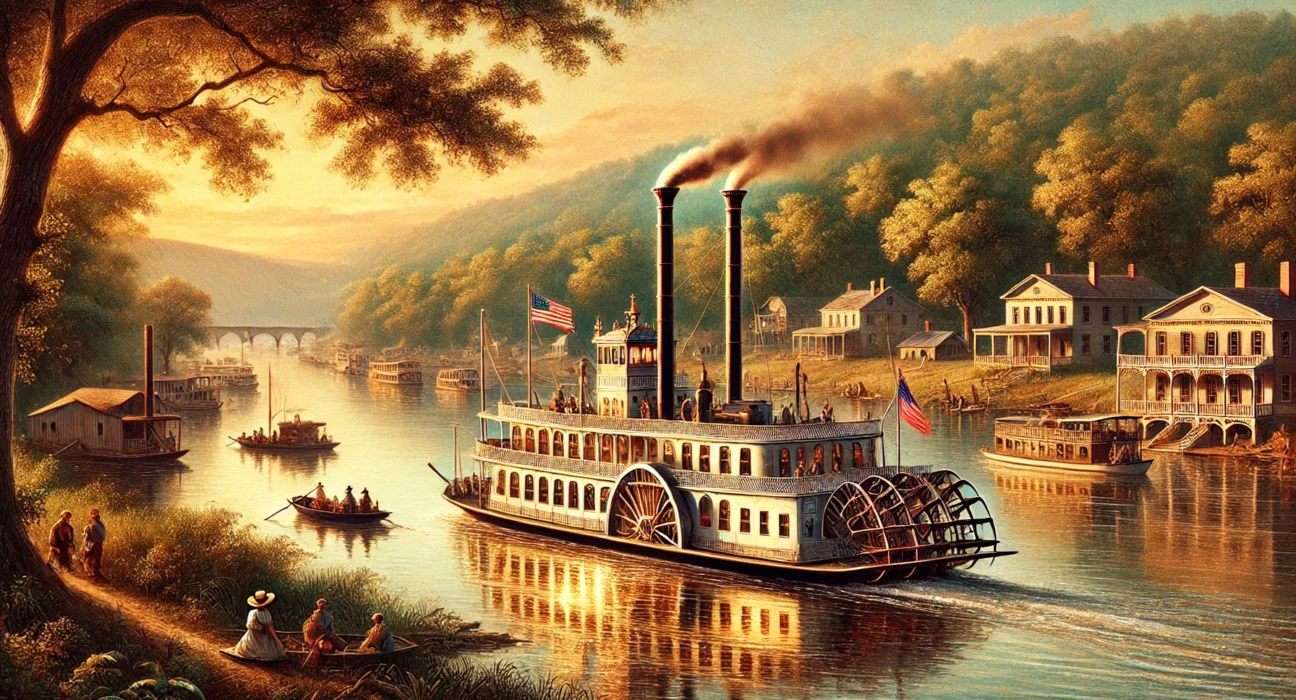Life on the Mississippi by Mark Twain, published in 1883, is a blend of memoir, travel narrative, and historical exploration. Twain draws from his experiences as a steamboat pilot on the Mississippi River before the American Civil War. It is one of Twain’s major works that showcases both his wit and his deep reflection on the changes in the American landscape, particularly with the coming of steam power and the industrial age.
Plot Summary
The Mississippi River, majestic and ever-changing, is at the heart of this tale. Its waters wind through centuries of American history, serving as both a vital artery for commerce and a symbol of the nation’s growth. Along its winding, unpredictable paths, a young man named Sam Clemens — who would later be known as Mark Twain — finds himself drawn to the life of a steamboat pilot. The river’s charm and its promise of freedom call to him as if it were a living, breathing force.
As a boy, Sam is enchanted by the steamboats that glide through the water, their great chimneys puffing smoke, their paddle wheels churning the current. Every day in his small village, excitement fills the air as the locals gather to watch these vessels arrive. Boys like Sam dream of life aboard one of these marvels, their imaginations captured by the clamor and grandeur of the riverboats. The pilots, standing confidently at the helm, become heroes to these boys, the very embodiment of adventure and skill. Sam’s deepest wish is to join their ranks, to learn the river’s secrets and command one of these floating leviathans.
Sam’s dream becomes a reality when he is taken on as a cub pilot under the guidance of Mr. Bixby, a stern and experienced man. Mr. Bixby is the epitome of river knowledge, a man who can read the Mississippi like a book. His sharp eyes see beyond the surface of the water, discerning the dangers hidden beneath: shifting sandbars, hidden snags, and treacherous currents. Under Mr. Bixby’s tutelage, Sam begins the grueling process of learning the river. It is no easy task. The Mississippi is fickle and ever-changing, requiring constant vigilance. A bend in the river that is safe one day may be deadly the next.
Sam’s education is both rigorous and exhilarating. He learns to anticipate the river’s moods, to recognize landmarks that shift with the seasons, and to steer the great steamboat with precision. There is a rhythm to the work, a delicate dance between man and nature. But it is not without its perils. One mistake can mean disaster — the loss of cargo, the destruction of the vessel, or even the lives of those aboard. Sam grows under the weight of these responsibilities, his admiration for the river deepening with each passing day.
Yet, as Sam masters the river’s many nuances, he begins to notice that the Mississippi itself is undergoing changes. The advent of railroads is steadily transforming the landscape. Towns once bustling with river traffic are becoming ghostly quiet. The steamboat industry, once the lifeblood of these communities, is slowly but surely giving way to the faster, more efficient trains. Sam observes these changes with a mix of awe and sorrow, aware that the world he has come to love is slipping away. The Mississippi remains, as powerful and untamed as ever, but the life it once supported is fading.
In the course of his travels, Sam encounters a cast of characters as varied and unpredictable as the river itself. There are rival pilots, each fiercely protective of their own knowledge of the river’s twists and turns. There are gamblers and con men, ever-present on the steamboats, plying their trade among the unsuspecting passengers. There are hardworking deckhands, sweating and cursing under the burden of loading and unloading cargo. And there are passengers from all walks of life — some seeking fortune, others merely adventure — all bound together by the river and its winding path.
Through it all, Sam’s love for the Mississippi never wavers. He relishes the freedom of the river, the thrill of navigating its unpredictable waters, and the camaraderie of life aboard the steamboat. But as he grows older, the changes around him become impossible to ignore. The steamboats are fewer and farther between, their once-grand whistles growing silent. The river towns that once bustled with life are shrinking, their economies no longer fueled by river trade.
Eventually, Sam must leave the river behind. His piloting days come to an end, and he moves on to other pursuits. But the Mississippi remains with him, a constant presence in his memory, a symbol of a simpler, wilder time. As he returns to the river years later, he is struck by how much has changed. The steamboats are all but gone, replaced by newer, faster modes of transportation. Yet the river itself endures, indifferent to the passage of time, still as mighty and mysterious as ever.
Standing on the banks of the Mississippi once more, Sam reflects on the passage of time and the impermanence of human endeavors. The river, which had been so central to his life and the lives of so many others, has outlasted them all. It flows on, as it always has, carrying with it the stories of those who once lived and worked along its shores. And though Sam’s time on the river has passed, he knows that a part of him will always belong to it.
In this ever-changing world, where progress marches forward and leaves the past behind, the Mississippi River remains a reminder of what once was. It is a place where adventure and danger walk hand in hand, where men like Sam Clemens found purpose and passion, and where the heartbeat of a young nation could be felt in every bend, every eddy, and every twist of the current.
Main Characters
Mark Twain (Samuel Clemens): As both the narrator and protagonist, Twain brings his sharp wit, sense of adventure, and deep affection for the Mississippi River to the forefront. He reflects on his youthful ambition to become a steamboat pilot, his experiences on the river, and his observations on the profound changes brought by technology and time.
Mr. Bixby: Twain’s mentor, who teaches him the intricate skill of navigating the Mississippi River as a steamboat pilot. Bixby is an experienced and no-nonsense figure, playing a key role in shaping Twain’s early professional life.
Various River Folk: Throughout the narrative, Twain introduces numerous characters, such as steamboat captains, pilots, passengers, and townspeople along the river, providing a vivid portrayal of life in the American South during the 19th century.
Theme
The Transformation of the Mississippi River: One of the central themes is the changing nature of the Mississippi itself. Twain reflects on how the river, once wild and untamed, became more controlled and commercially vital due to the steamboat industry. He laments the loss of the river’s raw beauty but also admires the technological advancements that have transformed travel and trade.
The Passage of Time: Twain continually contrasts his youthful experiences on the river with his later observations as an older man. The book is filled with a sense of nostalgia, where the past is romanticized, and the inevitability of change is often tinged with melancholy.
Industrialization and Progress: The steamboat symbolizes the march of progress and industrialization. While Twain marvels at the ingenuity that has made river travel more efficient, he also critiques the greed and destruction that often accompanies technological advancement.
Human Ingenuity and Mastery of Nature: The intricate skill required to navigate the unpredictable Mississippi River is symbolic of man’s determination to understand and control nature. Twain’s detailed accounts of learning to read the river emphasize this motif, portraying the pilot as an artist mastering a constantly changing canvas.
Writing Style and Tone
Twain’s writing in Life on the Mississippi is a masterful blend of humor, satire, and nostalgia. His style is conversational, making readers feel as though they are being personally regaled with stories from a seasoned traveler. Twain uses vivid descriptions of the Mississippi River, blending factual historical accounts with imaginative and humorous asides. His keen observations on society, human nature, and the American landscape are often delivered with biting wit, but they are tempered by moments of genuine reflection and reverence for the river.
The tone of the book shifts between lighthearted and melancholic. While Twain enjoys recounting humorous anecdotes about his time as a young steamboat pilot, he also imbues the narrative with a sense of loss. The industrialization of the Mississippi and the decline of the steamboat industry are recurring themes that carry an undercurrent of wistfulness for a bygone era.
We hope this summary has sparked your interest and would appreciate you following Celsius 233 on social media:
There’s a treasure trove of other fascinating book summaries waiting for you. Check out our collection of stories that inspire, thrill, and provoke thought, just like this one by checking out the Book Shelf or the Library
Remember, while our summaries capture the essence, they can never replace the full experience of reading the book. If this summary intrigued you, consider diving into the complete story – buy the book and immerse yourself in the author’s original work.
If you want to request a book summary, click here.
When Saurabh is not working/watching football/reading books/traveling, you can reach him via Twitter/X, LinkedIn, or Threads
Restart reading!








